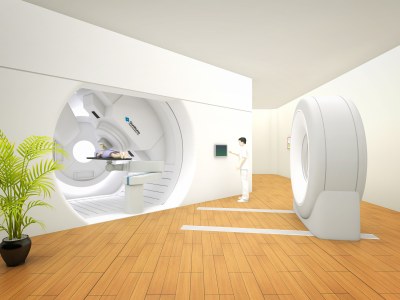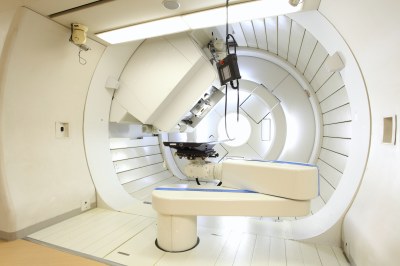Signed contract with Social Medical Corporation TEISHINKAI
June 17, 2014
Sumitomo Heavy Industries, Ltd. (President and CEO: Shunsuke Betsukawa; hereinafter referred to as “SHI”) today announces that it has finalized a contract with Social Medical Corporation TEISHINKAI (Chairman: Sadahisa Tokuda; hereinafter referred to as “TEISHINKAI”) in Sapporo, Hokkaido Pref. to supply a proton therapy system.

The new proton therapy system has one gantry treatment room in vertical arrangement with a short length compact gantry and a 230Mev cyclotron which enables significant space saving. The facility is planned based on the world’s first design that makes it possible to extend to two treatment rooms by extension of building, a rotating gantry and beam line in the future. Either of conventional broad beam irradiation or pencil beam scanning can be selected by using Multi-purpose nozzle, depending on treatment planning for a targeted disease. Furthermore, accurate patient positioning by 2D & 3D image guidance will be possible.
Proton therapy is a kind of radiotherapy based on accelerating protons, which are the nuclei of hydrogen atoms, to a high energy level before irradiation and concentrating dose on cancer cells. Since healthy tissues in the vicinity of the cancer cells are not negatively affected, it is possible to provide therapy with few side effects. Unlike surgical procedures, this is a gentle and less impact treatment that allows patients to be treated as outpatients and for this reason it is attracting attention around the world.
About TEISHINKAI
TEISHINKAI has 3 hospitals, 3 clinics and 20 aged care facilities in Sapporo and Wakkanai city and has contributed greatly to the regional healthcare. The proton therapy system will be installed annexed to a new hospital building which will be constructed at Higashi-ku, Sapporo, Hokkaido pref. and it is expected to play a big role in multidisciplinary cancer treatment combined with latest X-ray radiotherapy, surgery and chemotherapy.
About SHI
SHI delivered the first proton therapy system in 1997 to National Cancer Center Hospital East, which was the first hospital-based proton therapy facility in Japan and the second in the world. The facility has kept stable operation over 15 years. Since then, SHI has received orders from Chang Gung Memorial hospital in Taiwan, Aizawa hospital in Japan, and Samsung Medical Center in Korea. These facilities are preparing the commencement of treatment. SHI will continue to contribute towards the wide use of proton beam therapy for cancer treatment around the world, in collaboration with the customers.
1. Features of Proton Therapy
One of the promising therapeutic methods against cancer is proton therapy. A proton beam is obtained by accelerating the proton, the atomic nucleus of hydrogen, to high energy level. One of the features of proton therapy is the optimal dose distribution in the human body. Proton beam's Bragg Peak*1 makes this radiation very effective for the targeted irradiation of the tumor with lower side effect to surrounding healthy tissues.
*Note 1: Bragg Peak
Bragg Peak is a physical characteristic specifically available in a charged particle such as proton and not available in x-rays, which are used for conventional photon radiotherapy. The proton enters into the body with a relatively low dose and deposits energy at a predetermined depth and then vanishes at the depth.
2. Proton Therapy System
[Cyclotron]
The proton is accelerated to 230MeV*2 by using Cyclotron. Cyclotron enables a short treatment time with high dose rate and provides a continuous beam which is preferable for respiration gating irradiation because the beam can be delivered to a patient at any possible time.
[Beam Transport System]
The proton accelerated by Cyclotron is adjusted to the energy amounts planned for each patient and transported through Beam Transport System to Gantry Treatment System.
[Gantry Treatment System]
The targeted tumor can be irradiated from 360 degree angle range by using a rotating gantry without uncomfortable postures for each patient. Gantry Treatment System is equipped with a rotating gantry, an irradiation nozzle, an X-ray digital radiography system, and a treatment couch. The proton beam passing out of the rotating gantry is formed by the irradiation nozzle in shapes corresponding to the tumor.
Photo: *Note 2: MeV: Mega Electron Volts.
Electron volt (eV) is a unit of energy. One million eV is equivalent to 1MeV.

